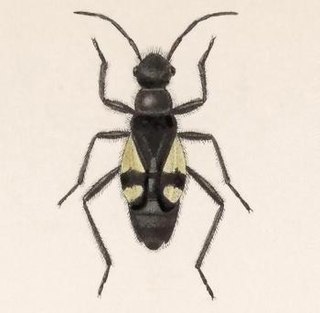Stridulation is the act of producing sound by rubbing together certain body parts. This behavior is mostly associated with insects, but other animals are known to do this as well, such as a number of species of fish, snakes and spiders. The mechanism is typically that of one structure with a well-defined lip, ridge, or nodules being moved across a finely-ridged surface or vice versa, and vibrating as it does so, like the dragging of a phonograph needle across a vinyl record. Sometimes it is the structure bearing the file which resonates to produce the sound, but in other cases it is the structure bearing the scraper, with both variants possible in related groups. Common onomatopoeic words for the sounds produced by stridulation include chirp and chirrup.

Icterids or New World blackbirds make up a family, the Icteridae, of small to medium-sized, often colorful, New World passerine birds. The family contains 108 species and is divided into 30 genera. Most species have black as a predominant plumage color, often enlivened by yellow, orange, or red. The species in the family vary widely in size, shape, behavior, and coloration. The name, meaning "jaundiced ones" comes from the Ancient Greek ikteros via the Latin ictericus. This group includes the New World blackbirds, New World orioles, the bobolink, meadowlarks, grackles, cowbirds, oropendolas, and caciques.

The Leptotyphlopidae are a family of snakes found in North America, South America, Africa and Asia. All are fossorial and adapted to burrowing, feeding on ants and termites. Two subfamilies are recognized.

The bearded sakis, or cuxiús, are five or six species of New World monkeys, classified in the genus Chiropotes. They live in the eastern and central Amazon in South America, ranging through southern Venezuela, Guyana, Suriname, French Guiana and northern and central Brazil. The species are entirely allopatric, their distributions being separated by major rivers.

The Cylindrophiidae are a monotypic family of secretive, semifossorial, non-venomous snakes containing the genus Cylindrophis found in southeastern Asia. These are burrowing snakes and most have a banded pattern on the belly. Currently, 13 species are recognized, all with no subspecies. Common names include Asian pipe snakes or Asian cylinder snakes.

Ctenolepisma is a genus of primitive insects in the order Zygentoma, closely related to the silverfish and firebrat but less reliant on human habitation, some species being found both indoors and outdoors and some found exclusively outdoors. The genus is distributed nearly worldwide in warm regions. Australia lacks native Ctenolepisma, but is home to introduced species.

The Sierolomorphidae are a family of 13 extant species of wasps, in the genera Sierolomorpha and Proscleroderma, mostly found in the Northern Hemisphere. They are rare and very little is known of their biology. A fossil species Loreisomorpha nascimbenei has also been placed in the family.

Moenkhausia is a genus of freshwater fish in the family Characidae native to tropical and subtropical South America. These are medium-sized tetras where the largest species only reach around 12 cm (4.7 in).

Craugastoridae, commonly known as fleshbelly frogs, is a family of New World direct-developing frogs. As delineated here, following the Amphibian Species of the World, it contains 129 species. They are found from the southern United States southwards to Central and South America.

Largidae is a family of insects within the order Hemiptera. They are commonly known as bordered plant bugs because many have contrasting coloured edges to their hemelytra. There are fifteen genera and about one hundred species. They are mostly wide-bodied, have no ocelli and have a four-segmented rostrum. The bugs in this family are generally ground-dwelling or they scramble around in plants, bushes and trees. They are phytophagous, feeding on plant juices and seeds.

Bucchich's goby is a species of goby native to the Eastern Mediterranean Sea and perhaps the Black Sea. It has traditionally been considered to be more widespread, but in 2016 the similar incognito goby was described. It had been confused with the Bucchich's goby and much information formerly published for this species is now considered to actually be for the incognito goby.

Scantius aegyptius, the Mediterranean red bug, is a species of red bug in the family Pyrrhocoridae, that is a pest of plant species in the family Malvaceae.

Largus bipustulatus is a species of bordered plant bug in the family Largidae. It is found in Central America and North America.

Largus cinctus is a species of bordered plant bug in the family Largidae. It is found in Central America, North America, and South America.

Arhaphe is a genus of bordered plant bugs in the family Largidae. There are 26 described species in Arhaphe. The genus is one of a small number of hemipterans known to possess a sound-producing stridulitrum, in which the hind femur is rubbed against the costal margin of the forewings.
Arhaphe carolina is a species of bordered plant bug in the family Largidae. It is found in Central America and North America.
Colobathristidae is a family of true bugs in the order Hemiptera. There are more than 20 genera and 90 described species in Colobathristidae.

Malcidae is a family of true bugs in the order Hemiptera. There are at least 4 genera and more than 40 described species in Malcidae.

Melacoryphus is a genus of seed bugs in the family Lygaeidae. There are about 11 described species in Melacoryphus, found in Central and North America.

Largus maculatus is a species of bordered plant bug in the family Largidae. It is found in Central America and North America.

















